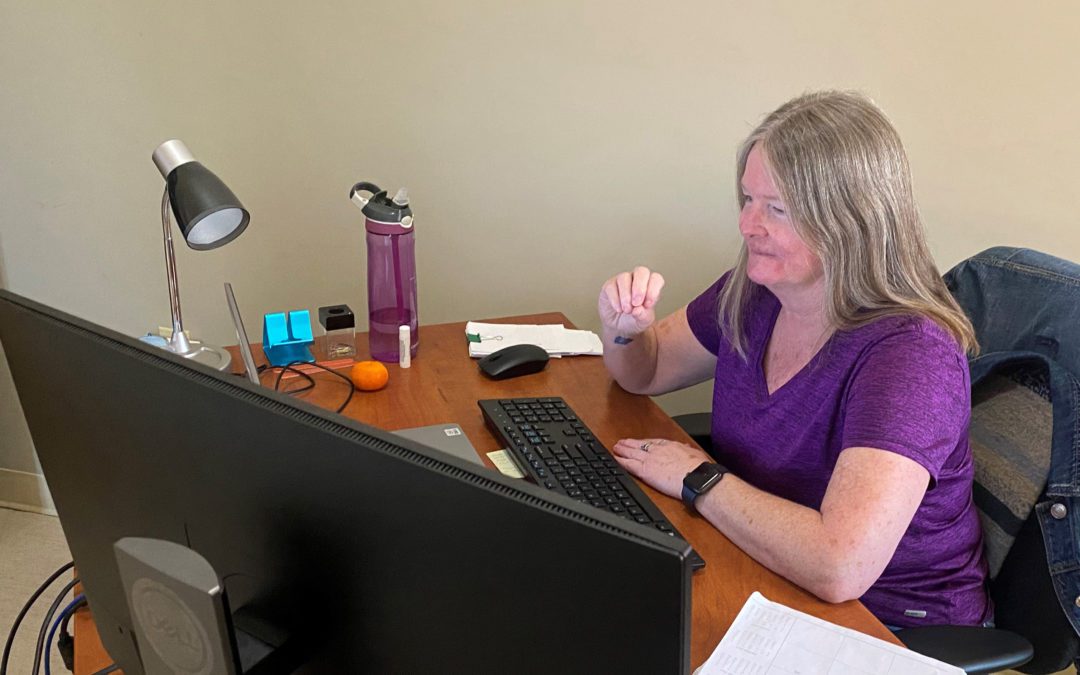Global Accessibility Awareness Day a good starting point for online inclusion
Video communications platforms like Zoom bridge distances, making meetings, gatherings, and events around the world more inclusive. But, the technologies that help facilitate communication, can also create new challenges for people that communicate using sign language, like Barb Downey, a Facilitator of Community Services at DeafBlind Ontario Services in Peterborough.
American Sign Language (ASL) is a visual language with the same linguistic properties as spoken languages, but different grammar than English. The Accessible Canada Act acknowledges ASL, Langue des signes québéquoise (LSQ), and Indigenous sign languages as the primary languages for communication by people who are Deaf in Canada.
“ASL is my first language… in a virtual environment, it is important that I communicate with the translation of an interpreter, rather than through the chat function,” said Barb through an interpreter.
An ASL interpreter is trained to translate between spoken English and ASL, they allow for effective communication between individuals who are Deaf or hard of hearing and the hearing population.
When it comes to virtual meetings, being able to clearly see the interpreter is essential to communication. “In my experience, smaller gatherings of under 10 people are more accessible than large groups. In particular, Zoom makes it easier to pin or spotlight the interpreter, while seeing other people interact in the meeting.”
“While in large online settings, there are many thumbnail displays of people…sometimes a couple pages of them. If a person does not identify themselves, I may not know who is speaking. The same goes for people that talk over one another, making it difficult for the interpreter to translate everyone. This means I may miss important information, which also happens when the meeting freezes or lags… creating a barrier to communication,” said Barb.
Thursday, May 19th 2022, marks the 11th annual Global Accessibility Awareness Day (#GAAD). This day aims to raise awareness about digital (web, mobile, software, etc.) access and a commitment to inclusion for more than one billion people around the world with diverse abilities.
Over 1.3 million or 5% of Canadians aged 15 years and over have a hearing disability.
“Every person deserves the same experiences on the web, whether they are accessing online content, the news, purchasing products and services, or participating in a virtual gathering. For people who are Deaf or hard of hearing, this boils down to equal access to communication,” said Roxanna Spruyt, CEO of DeafBlind Ontario Services.
“Technology has come a long way in bridging the gap and helping Deaf people connect from afar. However, in my opinion, there is more that can be done to make virtual meetings and events more inclusive,” said Barb.
According to Barb, some ways to make virtual meetings more accessible include scheduling frequent breaks. “The hearing population can look away from the online meeting and still listen to the conversation or presentation. While someone who is Deaf must focus and constantly watch the screen. After long periods of time, this can strain your eyes and be tiring.”
“Avoiding sharing your screen or a presentation for long periods of time is helpful too. This becomes the dominant screen, making the interpreter window small. Another tip is to share meeting or event materials in advance,” said Barb.
“Look and speak directly to the person who is Deaf, not the interpreter. Avoid personal conversations with the interpreter, they are working as a means of language transmission, not as a participant,” adds Roxanna.
“The digital world continues to reshape society on many levels, its impact on daily living is undeniable. However, we need to consider the population that has a disability, whether visible or not. Barriers to online inclusivity are ongoing, Global Accessibility Awareness Day is a good starting point,” said Roxanna.
Learn more about tips for using an interpreter at www.deafblindontario.com/sensory-loss/communication-methods/.




Recent Comments